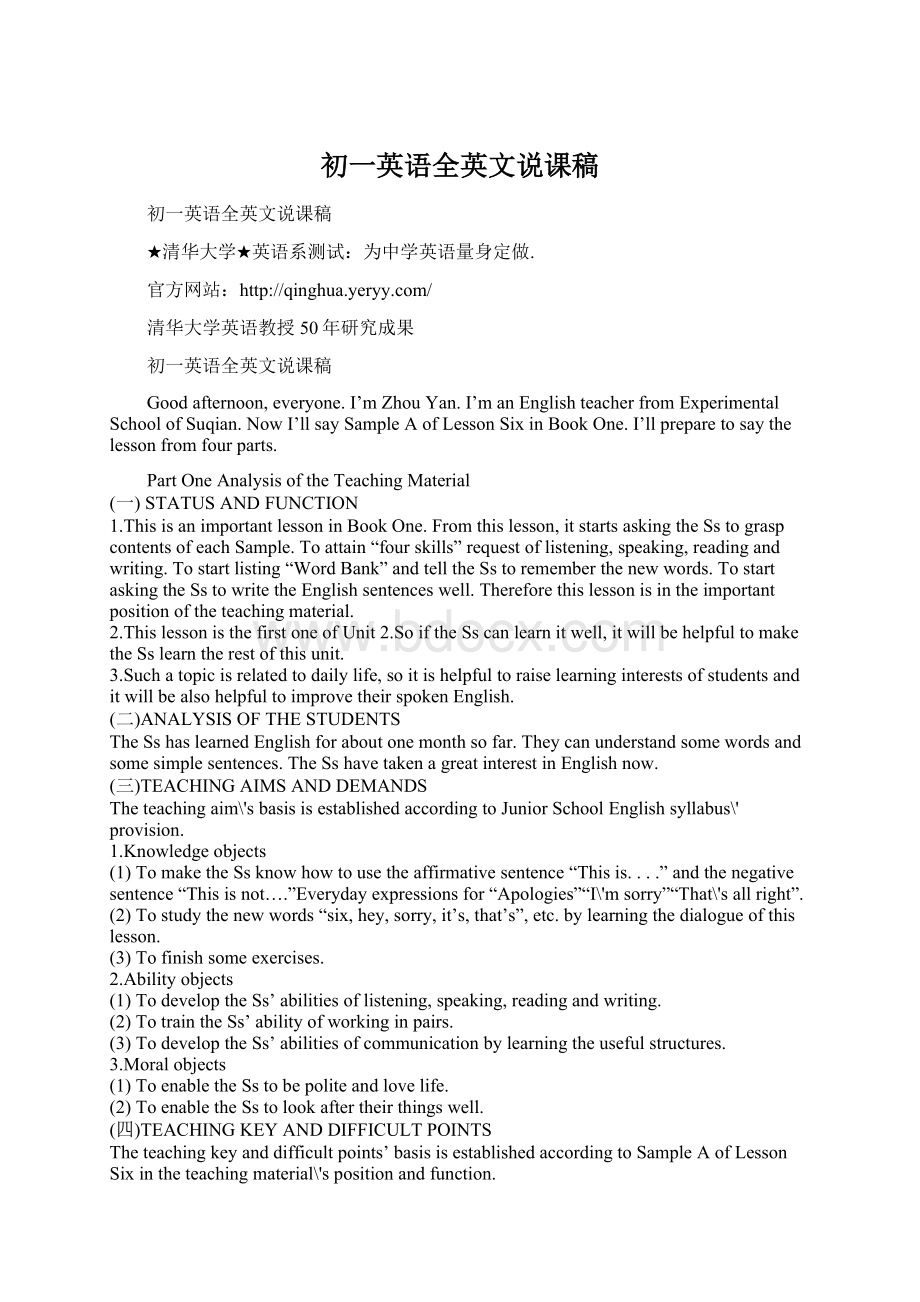初一英语全英文说课稿.docx
《初一英语全英文说课稿.docx》由会员分享,可在线阅读,更多相关《初一英语全英文说课稿.docx(33页珍藏版)》请在冰豆网上搜索。

初一英语全英文说课稿
初一英语全英文说课稿
★清华大学★英语系测试:
为中学英语量身定做.
官方网站:
清华大学英语教授50年研究成果
初一英语全英文说课稿
Goodafternoon,everyone.I’mZhouYan.I’manEnglishteacherfromExperimentalSchoolofSuqian.NowI’llsaySampleAofLessonSixinBookOne.I’llpreparetosaythelessonfromfourparts.
PartOneAnalysisoftheTeachingMaterial
(一)STATUSANDFUNCTION
1.ThisisanimportantlessoninBookOne.Fromthislesson,itstartsaskingtheSstograspcontentsofeachSample.Toattain“fourskills”requestoflistening,speaking,readingandwriting.Tostartlisting“WordBank”andtelltheSstorememberthenewwords.TostartaskingtheSstowritetheEnglishsentenceswell.Thereforethislessonisintheimportantpositionoftheteachingmaterial.
2.ThislessonisthefirstoneofUnit2.SoiftheSscanlearnitwell,itwillbehelpfultomaketheSslearntherestofthisunit.
3.Suchatopicisrelatedtodailylife,soitishelpfultoraiselearninginterestsofstudentsanditwillbealsohelpfultoimprovetheirspokenEnglish.
(二)ANALYSISOFTHESTUDENTS
TheSshaslearnedEnglishforaboutonemonthsofar.Theycanunderstandsomewordsandsomesimplesentences.TheSshavetakenagreatinterestinEnglishnow.
(三)TEACHINGAIMSANDDEMANDS
Theteachingaim\'sbasisisestablishedaccordingtoJuniorSchoolEnglishsyllabus\'provision.
1.Knowledgeobjects
(1)TomaketheSsknowhowtousetheaffirmativesentence“Thisis....”andthenegativesentence“Thisisnot….”Everydayexpressionsfor“Apologies”“I\'msorry”“That\'sallright”.
(2)Tostudythenewwords“six,hey,sorry,it’s,that’s”,etc.bylearningthedialogueofthislesson.
(3)Tofinishsomeexercises.
2.Abilityobjects
(1)TodeveloptheSs’abilitiesoflistening,speaking,readingandwriting.
(2)TotraintheSs’abilityofworkinginpairs.
(3)TodeveloptheSs’abilitiesofcommunicationbylearningtheusefulstructures.
3.Moralobjects
(1)ToenabletheSstobepoliteandlovelife.
(2)ToenabletheSstolookaftertheirthingswell.
(四)TEACHINGKEYANDDIFFICULTPOINTS
Theteachingkeyanddifficultpoints’basisisestablishedaccordingtoSampleAofLessonSixintheteachingmaterial\'spositionandfunction.
1.Keypoints:
(1).TohelptheSstocommunicatewitheachother.
(2).ToenabletheSstostudyingroupsandco-operateskillfully.
(3).TodeveloptheSs’interestinEnglish.
2.Difficultpoints:
(1)Howtomakedialoguesandactthemout.
(2)Howtowritetherightwholesentences.
(五)TEACHINGAIDS
Multi-mediacomputer,Taperecorder,Software:
PowerpointorAuthorware,schoolthingsandsoon.Theywillbeneededinthislesson.
PartTwoTheTeachingMethods
1.Communicativeteachingmethod
2.Audio-visualteachingmethod
3.Task-based”teachingmethod
Asweallknow:
themaininstructionalaimsoflearningEnglishintheMiddleSchoolistocultivatestudents’abilitiesoflistening,speaking,reading,writingandtheirgoodsenseoftheEnglishlanguage.SointhislessonI’llmainlyuse“Communicative”teachingmethod,“Audio-visual”teachingmethodand“Task-based”teachingmethod.Thatistosay,I’lllettheSstogetabetterunderstandingofthekeystructureofthedialogue.I’llgivetheSssometasksandarrangefivekindsofactivities:
talking,guessinggames,watchingCAI,actingoutSampleAandhavingacompetition.
Teachingspecialfeatures
TousethesemethodsarehelpfultodeveloptheSs’thought.
PartThreeSTUDYINGWAYS
1.TeachtheSshowtobesuccessfullanguagelearners.
2.LettheSspass\"Observation—Imitation—Practice\"tostudylanguage.
3.TeachtheSshowtomasterdialoguesandhowtocommunicatewithothers.
Teachingspecialfeatures:
LettheSscommunicatewitheachotherandadoptcompetitionmethodstodeveloptheSs’keeninterestinEnglish.
PartFourTeachingProcedure
I’llfinishthislessoninfoursteps.FirstI’lldividetheSsintofourgroupsandbringacompetitionintotheclass.Atlastlet’sseewhichgroupisthewinner.
Step1Warm-up
1.FreetalkbetweenTandSs.
Suchas:
Hi,I’m....What’syourname?
Thisis….Howdoyoudo?
Whoishe/she?
Howareyou?
Whocancountfrom1to5?
What’sthisinEnglish?
etc.
2.Agame:
AsktheSstogiveTsomeschoolthings.Forexample:
T:
Givemeyourbook.(ruler,box,pen,table,knife,etc.)
T:
Thisisyourbook.Thisisnotmybook.It’syourbook.etc.
InthiscourseI’llaskthemtomakeadialoguegroupbygroupwithoutrepetition.Findoutwhichgroupwillmakethemostdialogues.
Purposeofmydesigning:
IthinkitisimportanttoformabetterEnglishlearningsurroundingfortheSsbyimitatingandatthesametimeitisnecessarytoprovidesituationstoreviewlearnedknowledge.
Step2.Presentation
Thiscourseisveryimportant.I’llmainlytalkaboutthisstep.
I’lluseCAItopresentthewholedialogue.ArrangesomesituationstohelpSsunderstandSampleA.
Firstscene:
Thereisabagonthefloor.Bispickingitupandgetreadytoleave.NowAistalkingwithB.
A:
Hi,B.Howareyoutoday?
B:
I’mfine,thankyou.Andyou?
A:
I’mfine,too.Oh,thisismybag.
B:
No,thisisnotyourbag.It’smybag.
A:
(Lookclosely)Oh,I’msorry.
B:
That’sallright.
(Atthesametime,CisrunningupandhittingA.)
C:
Oh,I’msorry.
A:
That’sOK.
I’llwritethekeypointsontheBbwhiletheyarewatching.Afterwatching,I’llteachthemtoreadthewordsandsentencesontheBb.Makesuretheycanreadthemwell.
Purposeofmydesigning:
TopresentSampleAbyCAIismucheasierfortheSstolearnandgraspthemeanings.CAIcanprovidearealsituationwithitssoundandpictureanditmakestherelationshipsbetweentheSsbetter.
Step3.Practice
Firstplaythetaperecorder.LettheSslistenandimitatethedialogue.Payattentiontotheirpronunciationandintonation.InthissteptheSsarerequiredtopractisetheSampleinpairsbyreadingthedialoguealoud.ThisstepisemployedtomaketheSsgrasptheSample.AtlastI’llasktheSstothinkhardandactitoutwithapartneraccordingtoSampleA.Thenfindoutwhichgroupwillactitoutwell.I’llgivethemredstars.
Purposeofmydesigning:
ThisstepisemployedtomaketheSsgetthegeneralideaofthedialogueasawholeone.AtthesametimelettheSshaveachancetopractisetheirlisteningandspokenability.
Step4.Production
InthisstepI’llgivetheSsafreespacetoshowtheirabilities.
Secondscene:
TheSsarehavingapicnic.It’shotandtheytakeofftheircoatsandputthemtogether.Theyaresinginganddancing,laughingandchatting.Afterthepicnic,theybegintolookfortheircoats.DandEaretalking.FandGaretalking.etc.
Afterwatching,I’llgivetheSssometaskstomakesimilardialogueswithoutrepetitionandfindoutwhichgroupwillmakemoredialogues.
Purposeofmydesigning:
“Task-based”teachingmethodisusedheretodeveloptheSs’abilityofcommunicationandalsotheirabilityofco-operationwillbewelltrained.TelltheSsweshouldbepoliteandtakegoodcareofourthings.Weshouldloveourlife.IthinkpropercompetitioncanarousetheSs’interestinEnglishlearning.IftheSscanfinishthistaskwell,theywillbenefitalotintheirspokenEnglish.
2.Skill1Model1.
I’llaskfourSsofthegroupstowritethesesentencesontheBbinthefourlines.
Thenchecktheirhandwriting,correcttheirmistakes.Findoutwhowillwritewellandwhosehandingisthebest.
3.FinishtheSs’workbook.
Purposeofmydesigning:
TochecktheknowledgeSshavelearnedinthislesson.
Step5.Homework:
(1)Recitethewordsasmanyaspossibleafterclass.
(2)MakeadialogueaccordingtoSampleAandwriteitintheexercisebook.
Purposeofmydesigning:
IthinkhomeworkissoimportantthattheSsshouldspeakEnglishasmuchastheycaninclassorafterclass.ItisnecessaryfortheSstodosomeextensiveexercisesafterclasstoconsolidatetheknowledgetheylearned.
BlackboardDesign
LessonSixSampleASixThisismy….heyThisisnotyour....sorryIt’smy....Pictureit’s=itisOh,I’msorry.that’s=thatisThat’sallright/OK.
★清华大学★英语系测试:
为中小学生英语量身定做.
官方网站:
清华大学英语教授50年研究成果
人教版初二英语下册语法
█现在进行时
现在进行时的基本用法
1.表示说话时正在进行的动作
常和now连用,有时用一个look、listen,来表now这一时间概念。
*Look!
Atrainiscoming.看,火车来了。
*Listen!
Heisplayingthepiano.听,他在弹琴。
2.表示现阶段正在进行的动作
但不一定是说话时正在进行。
常和atpresent,thisweek,thesedays…等时间状语连用。
*Whatlessonareyoustudyingthisweek?
你们本周学哪一课了?
(说话时并不在学)
3.现在进行时有时可用来表示一个在最近按计划或安排要进行的动作
即是说可以用来代替将来时,但此时,一般要与表示将来时的时间状语连用,而且仅限于少量动词。
如:
go,come,leave,start,arrive,return.sleep
*AreyougoingtoTianjintomorrow?
你明天去天津吗?
*Howmanyofyouarecomingtothepartynextweek?
你们有多少人下周要来参加晚会?
三、一般将来时
█一般将来时
1.begoingto+动词原形~
对于将要发生的事,或打算、计划、决定要做的事情时,皆以begoingto+动词原形的句型来表示。
因此此句型有be动词,所以是否用am,is,are,决定于主语。
1.肯定句:
主语+be(is,am,are)goingto+动词原形
IamgoingtoplayfootballnextSunday.
下周日我打算踢足球。
◇Heisgoingtotravelaroundtheworld.他计划周游世界。
◇Theyaregoingtomeetoutsidetheschoolgate. 他们打算在校门口见面。
◇Itisgoingtorain. 要下雨了。
2.否定句:
主语+be(am,are,is)notgoingto+动词原形
Wearenotgoingtohaveanyclassesnextweek. 下周我们不上课。
◇I’mnotgoingtobeateacher. 我不打算当老师。
◇Heisn’tgoingtoseehisbrothertomorrow. 他明天不准备去看他哥哥。
3.疑问句:
Be(Am,Is,Are)+主语+goingto+动词原形
◇Areyougoingtobeadoctorwhenyougrowup?
你长大了,打算当一名医生吗?
Yes,Iam.是的,我打算当。
No,I’mnot.不,我不打算当。
will同begoingto的用法相同
以今天为起点的所有将来时间,如:
thisafternoon/thisevening=tonight/tomorrow/
tomorrowmorn